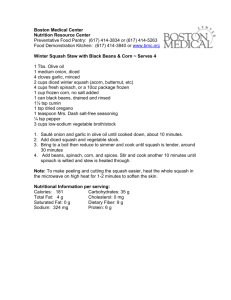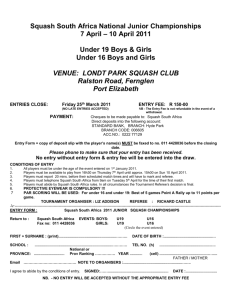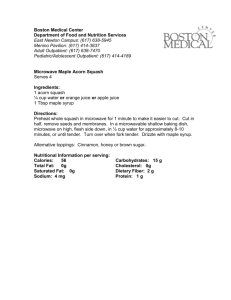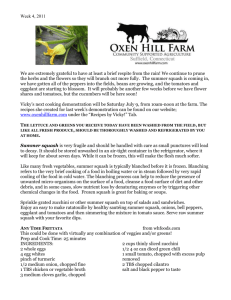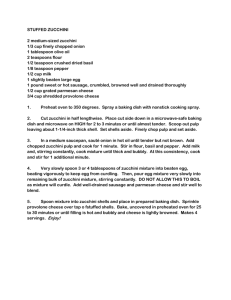Squash Variety Trial Safford Agricultural Center, 1998 Abstract
advertisement
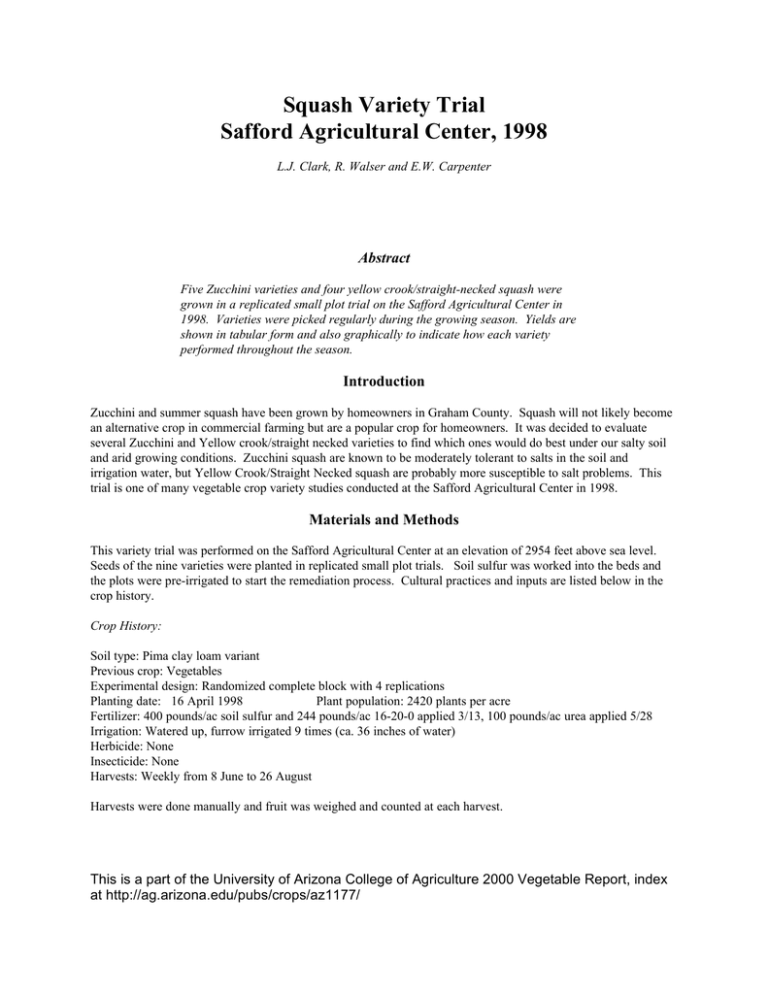
Squash Variety Trial Safford Agricultural Center, 1998 L.J. Clark, R. Walser and E.W. Carpenter Abstract Five Zucchini varieties and four yellow crook/straight-necked squash were grown in a replicated small plot trial on the Safford Agricultural Center in 1998. Varieties were picked regularly during the growing season. Yields are shown in tabular form and also graphically to indicate how each variety performed throughout the season. Introduction Zucchini and summer squash have been grown by homeowners in Graham County. Squash will not likely become an alternative crop in commercial farming but are a popular crop for homeowners. It was decided to evaluate several Zucchini and Yellow crook/straight necked varieties to find which ones would do best under our salty soil and arid growing conditions. Zucchini squash are known to be moderately tolerant to salts in the soil and irrigation water, but Yellow Crook/Straight Necked squash are probably more susceptible to salt problems. This trial is one of many vegetable crop variety studies conducted at the Safford Agricultural Center in 1998. Materials and Methods This variety trial was performed on the Safford Agricultural Center at an elevation of 2954 feet above sea level. Seeds of the nine varieties were planted in replicated small plot trials. Soil sulfur was worked into the beds and the plots were pre-irrigated to start the remediation process. Cultural practices and inputs are listed below in the crop history. Crop History: Soil type: Pima clay loam variant Previous crop: Vegetables Experimental design: Randomized complete block with 4 replications Planting date: 16 April 1998 Plant population: 2420 plants per acre Fertilizer: 400 pounds/ac soil sulfur and 244 pounds/ac 16-20-0 applied 3/13, 100 pounds/ac urea applied 5/28 Irrigation: Watered up, furrow irrigated 9 times (ca. 36 inches of water) Herbicide: None Insecticide: None Harvests: Weekly from 8 June to 26 August Harvests were done manually and fruit was weighed and counted at each harvest. This is a part of the University of Arizona College of Agriculture 2000 Vegetable Report, index at http://ag.arizona.edu/pubs/crops/az1177/ Analyses from saturated paste extracts from the experimental field and a typical water sampling from the irrigation well are included below: Sample pH Electroconductivity Total Dissolved Solids ppm Na Estimated SAR Soil 0-2 inches 7.81 6.42 4109 1020 9.9 Soil 6-8 inches 8.34 1.86 1190 322 6.0 Well water 7.53 2.06 1318 366 7.35 Results and Discussions Zucchini squash are moderately tolerant to salt (1) with a salinity threshold value for electroconductivity of 4.7 and a slope of 9 whereas salt tolerance for the Yellow summer squash is not readily available. With the high electroconductivity of the soil a yield reduction would be expected even from the Zucchini varieties. Using the formula Yr = 100 - B(Ke - A), where Yr is the relative yield, A is the salinity threshold, B is the slope or percent yield decrease per unit salinity increase above the threshold and Ke is the electroconductivity of the saturated soil paste, the yield potential for squash under field conditions can be calculated. With these values it is determined that Yr (0 - 2") = 84.5% and Yr(6-8") = 100%. This shows the importance of planting deep and irrigating every other row to push the salts away from the plant roots. Table 1 lists the varieties names and the type of squash together with the first and last harvest dates. The Tigress Zucchini and three of the four Yellow squash were slightly earlier than the other varieties, but not by a large amount. Table 2 shows the yields in 25 pound cartons, average fruit weight in ounces and the total number of fruit harvested over the entire season. Tigress and Onyx varieties of Zucchini squash appeared to produce more cartons of fruit and more individual squash per acre than the other Zucchini varieties, even though there were no statistical differences. There were statistical differences in fruit size, but no difference in quality was noticed. The number of fruit per plant was calculated and is listed to aid homeowners in their planting needs. The bottom half of Table 2 lists the Yellow squash data. Supersett and Superpik may produce slightly more fruit than the other two varieties, but differences were small and not statistically significant. Fruit weights were very similar and again, no quality differences were observed. The weekly harvest data are plotted in Figures 1 and 2 for the Zucchini and Yellow squash, respectively. In both squash types, the highest yielding variety produced more fruit through the entire growing season than the other varieties, with one exception. That was on the 6th harvest date. During that week a cold front moved through bringing more than half an inch of rain, cooler than normal temperatures and a reduction on solar radiation. For some reason, the top producing varieties on both squash types experienced a great reduction in fruit production under these conditions. An interesting side note from reference 2. Average summer squash yields in the US are 1200 cartons/ac. Yields seen at this site were 2 to 4 times higher than the US average. References 1. Maas, E.V. 1986. Salt Tolerance of Plants. Applied Agricultural Research Vol. 1, No. 1, pp. 12-16. SpringerVerlag New York. 2. Lorenz, O.A. and D.N. Maynard. 1988. Knott’s Handbook for Vegetable Growers, third edition. WileyInterscience Publication, New York. Table 1. Type of squash and harvest season for varieties grown at the Safford Agricultural Center, 1998. Variety Type First Harvest Last Harvest Green Zucchini 5 June 26 August Black/Green Zucchini 8 June 26 August Midnight F1 Black Zucchini 8 June 26 August Jaguar F1 Black Zucchini 8 June 26 August Rivera F1 Green Zucchini 8 June 26 August Zucchini Tigress F1 Onyx F1 Yellow Supersett F1 Crookneck 5 June 24 August Superpik F1 Straightneck 5 June 26 August Monet F1 Straightneck 8 June 26 August Picasso F1 Crookneck 5 June 24 August Table 2. Yields, average fruit weights and numbers of fruit harvested over the season on squash varieties grown at the Safford Agricultural Center, 1998. Variety Yield (Cartons1/acre) Fruit Weight (ounces) Fruit/plant Zucchini Tigress F1 4400 a Onyx F1 2 11.7 ab 62 4200 a 13.3 a 52 Midnight F1 3168 a 12.0 ab 44 Jaguar F1 2848 a 11.2 b 42 Rivera F1 2720 a 10.7 b 42 Average 3376 11.8 -- LSD(05) 1168 1.6 -- 18 6.8 -- CV(%) Yellow Supersett F1 2368 a 6.1 a 65 Superpik F1 2000 a 6.4 a 52 Monet F1 1816 a 5.9 a 50 Picasso F1 1704 a 6.4 a 43 Average 1968 6.1 -- LSD(05) 1056 1.0 -- 27 7.5 -- CV(%) 1. Cartons weigh 25 pounds. 2. Values within a column followed by the same letter are not significantly different at the 95% level of confidence using Duncan’s Multiple Range test. Figure 1. Number of Zucchini fruit picked per week by variety over the 1998 harvest season. Figure 2. Number of Yellow summer squash fruit picked per week by variety over the 1998 harvest season.
